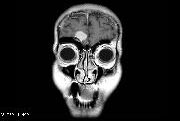Temporal arteritis is a condition within the spectrum of Giant Cell Arteritis. In this
condition, there may be pain with chewing or talking due to poor blood flow to the muscles
that move the jaw (especially the temporalis muscle). Visual symptoms may also occur. In
this condition, the muscular wall of a particular artery becomes inflamed, resulting in
narrowing of the artery and a reduced blood supply for its tissues. Sometimes the artery for the retina can be affected (resulting in diminished vision) or the temporalis muscle can be affected. In this kind of case, the muscle can be tender to the touch or a thick, tender artery can be palpated along the side of the head. This is an important condition to diagnose because and untreated case can result in blindness or stroke.
The most helpful clue to make the diagnosis of temporal arteritis is the clinical history. The
exam findings may be helpful, but they can be equivocal at times. Certain blood tests results
can also be helpful. Blood test abnormalities may include an elevated white blood cell
count, an elevated sedimentation rate (or ESR) or an elevated CRP. When these tests are
abnormal, patients are treated for temporal arteritis with corticosteroids such as
prednisone. It is rare that pain medicine is needed, and many patients feel immediate relief
with their steroid treatment.
The key test is considered the blood test called ESR (Westergren or Sed Rate). The ESR is a
test when red blood cells are added to a collection of saline or salt fluid. Normally blood
cells in saline solution settle to the bottom of the tube quickly. When the cells are taken
from blood containing inflammatory proteins, they repel each other, and they do not settle
to the bottom of the test tube quickly. These inflammatory proteins are not specific, and
may be elevated in other situations (such as cancer or infection).
Since there are times when the symptoms are serious or when the diagnosis is hard to
make, it helps to have a confirmatory test. A biopsy of the temporal artery is the so-called
gold standard method to make the diagnosis of temporal arteritis. This is an outpatient
surgery done over the side of the scalp, normally behind the hairline. A small piece of the
distal artery is removed, and it is examined under the microscope. In temporal arteritis, the
wall of the artery will appear to have white blood cells and inflammatory molecules
infiltrating it. A healthy artery has neither of these findings.
Although temporal arteritis can be a serious condition, it is normally curable. It is not
normally necessary for patients to need treatment for a long time. We do not know why this condition occurs. Although this might be considered an autoimmune condition, it does
not overlap well with other autoimmune conditions, and the reason it occurs remains a
mystery.
Treatment
When temporal arteritis is identified, appropriate treatment is corticosteroid medication.
This may be either prednisone 60 mg daily x 1 week, solumedrol 1 gram daily x 3 days, or a
similar high dose corticosteroid treatment. A gradual reduction of the dosage should
follow. Symptoms may respond quickly to these treatments, but extended therapy is often
necessary to prevent relapses.
Patients who do not respond to corticosteroids may require stronger medications, such as
cyclophosphamide. Medicines that address pain symptoms may be also be helpful.
